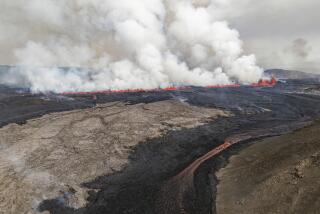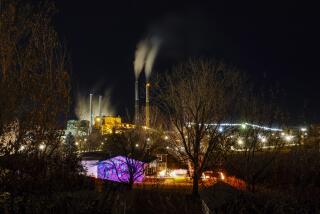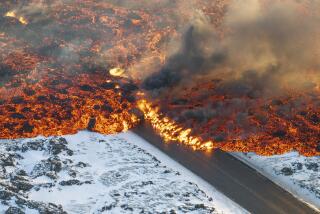Iceland divided over aluminum’s role in its future
- Share via
Reporting from Grundartangi, Iceland — Part of the cure — or cause — of Iceland’s spectacular economic meltdown sits here on a rugged fiord backed by frigid blue waters and snowcapped mountains.
It’s a massive aluminum smelter on the harbor’s edge, sprawling over a few hundred acres. Owned by Century Aluminum Co. of Monterey, Calif., and fueled by geothermal energy and hydropower, the plant churns out nearly 300,000 tons of aluminum a year, to be shipped to customers around the world.
When Iceland’s economy collapsed in 2008, pushing the country to the brink of bankruptcy, production here and at two other smelters continued, which helped keep exports alive through two years of painful recession. Now a budding economic recovery is underway, and Iceland is on track for a faster return to sustained growth than other debt-ridden nations in Europe, such as Greece or Ireland.
But that has only stoked a fierce debate over how big a role aluminum production should play in the future of this sparsely populated island. The metal already accounts for about one-seventh of Iceland’s entire economic output.
It’s a bitter fight pitting pro-business groups against environmental activists and others suspicious of the industry.
Lured by low energy costs, foreign aluminum companies are eager to expand operations. Their supporters say that large-scale investment projects are vital to spur economic growth and create jobs.
But such plans alarm those who not only warn of irreparable damage to the environment but blame Iceland’s ardent embrace of “Big Aluminum” for causing the country’s financial troubles in the first place, by igniting an unsustainable economic boom.
If the expansion plans are approved — two new plants are under discussion — what was traditionally a nation of fishermen would be on its way to becoming one giant aluminum smelter in the North Atlantic, critics say.
“We’re going too fast in a short time,” said Andri Magnason, a writer and filmmaker who is highly critical of the industry. “We’re putting all our eggs in one basket.”
It’s a basket that has grown to remarkable size, compared with other parts of the economy, in the last decade.
Iceland’s oldest aluminum smelter was established 42 years ago, but up until 2000, aluminum never accounted for more than about 3% of gross domestic product, on average.
That changed when the government began aggressively courting metals companies and approved construction of two large plants. By 2008, Iceland was producing about 870,000 tons of aluminum a year, virtually all of it destined for buyers abroad. That year, aluminum exports eclipsed fisheries exports in value for the first time in the island’s history.
The smelting companies import bauxite, the raw material for aluminum, from countries including the U.S., Ireland and Australia; bauxite is not mined in Iceland itself.
But smelting it here allows Iceland, with its many rivers, waterfalls, hot springs and volcanoes, to exploit its own natural resources by supplying the aluminum plants with hydropower and geothermal energy at competitive prices. Otherwise, there would be no market for all the clean energy Iceland is capable of producing.
“We are based in the middle of the North Atlantic Ocean. We are not connected to the mainland Europe grid,” said Bjarni Mar Gylfason, chief economist for the Federation of Icelandic Industries. “So we export energy in the form of aluminum.”
Iceland’s three smelters now consume at least five times as much electricity as all 320,000 of the country’s residents. The plants provide jobs for about 1,400 people.
Environmentalists acknowledge that by using clean energy, the plants in Iceland pollute less than coal-fired smelters in other countries. But they warn that the aluminum companies are extracting heat from the Earth faster than it can be replenished. Although the subterranean heat is virtually inexhaustible from a global perspective, digging too many wells to tap into the hot water and steam, without allowing enough time for nature to renew the supply, can deplete a local site over time.
“They have presented it … like it’s endless. Just drill a hole and everyone can get some,” said Magnason, the filmmaker, whose documentary “Dreamland” sharply criticizes the aluminum industry in Iceland. “It’s not like that.”
He and others suspect officials of offering sweetheart deals to the aluminum firms. The electricity rates that the state-owned power companies have offered the smelters have not been publicly disclosed.
There are other potential environmental costs. For Iceland’s biggest smelter, which opened in 2007 in the eastern part of the country, the government built a series of dams and a massive reservoir that environmentalists fear will speed up erosion and harm the area’s population of deer and pink-footed geese. (The mother of pop star Bjork, herself a major opponent of the aluminum industry, went on a hunger strike to try to stop the project.)
Anti-aluminum activists also say the deal to build the eastern smelter, owned by Pittsburgh-based Alcoa Inc., helped trigger the financial spiral that led to Iceland’s undoing.
Critics say the deal put Iceland in the sights of foreign investors, who suddenly started pouring money into the island, a boom that lasted from 2003 to 2008. Awash in unprecedented amounts of cash, Icelandic banks started lending and investing heavily. Interest rates shot up as businesses and credit-happy residents took out loans for all sorts of purchases.
Housing prices soared; so did the value of the currency, the krona. The banks became so over-leveraged that their liabilities equaled 10 times the entire country’s GDP, prompting some commentators to describe Iceland as a giant Viking hedge fund.
When the global financial meltdown hit in late 2008, the Icelandic economy imploded. Businesses collapsed, unable to pay back their loans; at one point, the stock market had lost 95% of its value from its height.
Others say it makes no sense to blame the Alcoa smelter deal for setting off the spiral.
“Of course it marked the beginning of an economic boom,” said Gylfason of the industries federation. But with global markets speculating madly everywhere at the time, “I’m sure that this economic crisis and this economic boom would’ve happened without the smelters being built.”
Now Iceland’s economy is starting to grow again, perhaps by a modest 2% this year, according to international forecasts. And Alcoa is pushing for permission to build another large smelter in the north.
Gylfi Zoega, an economist at the University of Iceland, said new investment in a major project could provide a shot of confidence without inflating expectations.
“The economy is in such a slump now that a boost would not create irrational exuberance,” Zoega said, though he warned against turning to the aluminum industry for “a quick fix.”
Environmental concerns have so far delayed a deal for Alcoa. Also, Iceland’s left-leaning government is far cooler toward the aluminum industry than its predecessor, which voters tossed out in anger over the country’s economic crash.
But opponents of the proposed Alcoa smelter aren’t resting easy.
“America is not allowing Alcoa into Yellowstone Park. But we are giving up our Yellowstone parks for Alcoa,” Magnason said. “Why does Alcoa not get the same permission in its own country while we are eager to sacrifice our own areas for it?”
Here in western Iceland, the smelter at Grundartangi sits in plain view from a nearby highway. Cars and trucks trundle in and out of the complex on an access road that a group of environmental activists tried to block three years ago.
The plant began operations in 1998 and employs more than 400 people. Production capacity increased steadily during Iceland’s boom years. Its owner, Century Aluminum, is now hoping to build another smelter outside Reykjavik, the capital, near the site of an old U.S. military base, but the plans have encountered a number of delays.
Century, a publicly traded company, also operates plants in Kentucky and West Virginia and mines bauxite in Jamaica.
“It’s very sensitive there. We’re right in the midst of a number of negotiations,” said company spokesman Michael Dildine, who declined to elaborate. “We typically keep a very low profile in Iceland.”
Activists are keeping pressure on the government to hold the line on aluminum’s expansion. The current environment minister is sympathetic to their concerns, but Magnason is worried that economic considerations may prevail.
“It’s like putting a lid on something that’s about to explode,” he said. “We have had some progress. But in other ways, when you have a billion dollars waiting to flow into the economy, when you have 9% unemployment … things can go wrong.”
More to Read
Inside the business of entertainment
The Wide Shot brings you news, analysis and insights on everything from streaming wars to production — and what it all means for the future.
You may occasionally receive promotional content from the Los Angeles Times.











